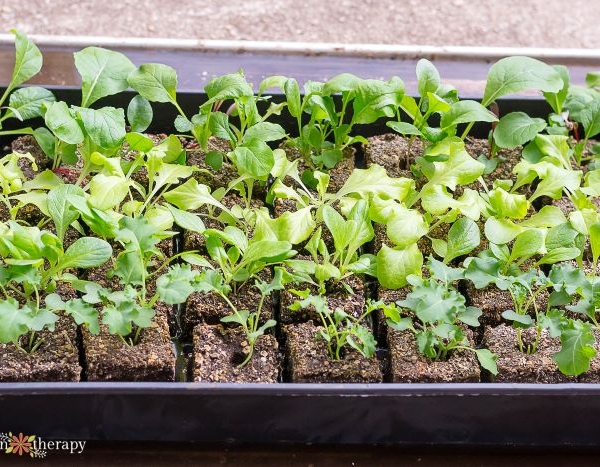Herbs are a must in my garden. I use fresh herbs in cooking year-round and love to keep them close to the kitchen for easy harvest. Join me as we tour the transformation of my perennial herb container garden into a culinary kitchen garden that looks as beautiful as it is tasty.
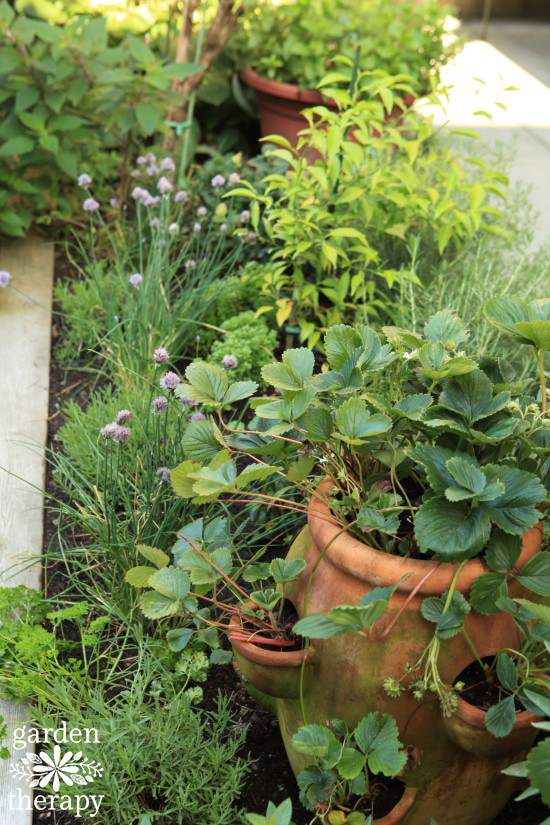
A kitchen garden is a wonderful way to keep fresh produce and herbs right outside your backdoor ready for cooking. When you’re growing herbs, you want to ensure things are contained and tidy since it’s right next to your entertaining space.
Here is how I grew a culinary yet decorative kitchen garden!
Before the Culinary Garden Upgrade
In one of my previous homes, the garden spaces were near the edges of the property. We had a small deck off the kitchen with stairs that led down to a patio space. I created a perennial herb garden in containers for easy access from the kitchen.
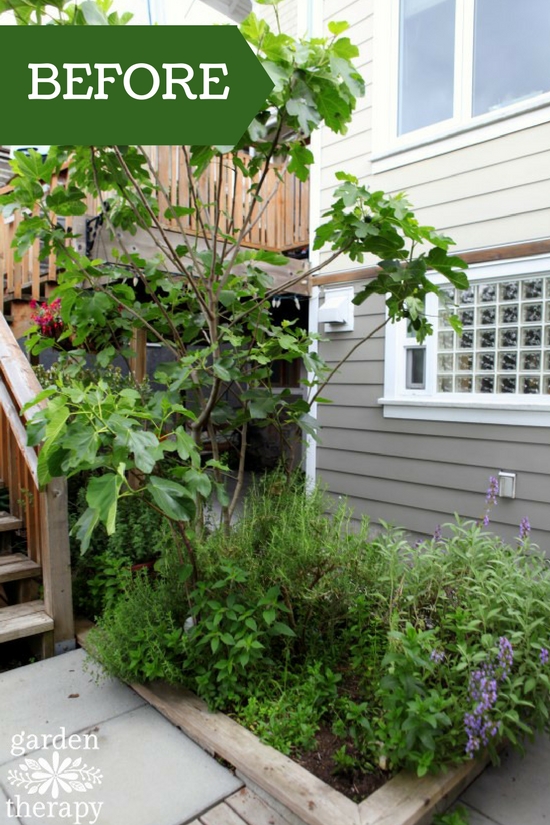
When I moved, a perfect in-ground bed was ready to become the kitchen garden. The 4-foot by 10-foot space is mostly in full sun and conveniently located at the base of the stairs leading down from the deck.
I lugged over the herb pots from the old house and transplanted them into the soil surrounding a young fig tree that came with the garden. The soil was terrible, but I built it up with layers of homegrown compost over the next few years.
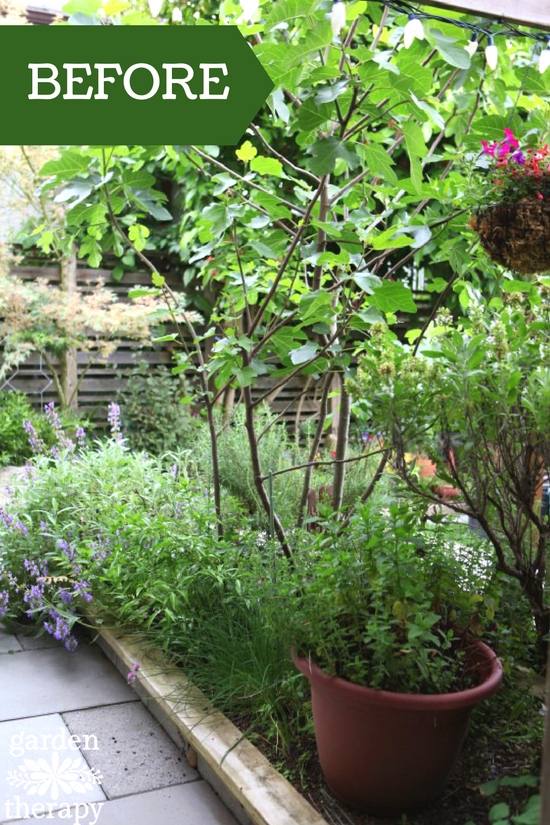
Bright, direct sunlight and healthy soil proved to be the perfect combination. All of the herbs grew like weeds, and before I knew it, I had monstrous sage, rosemary, thyme, oregano, and mint plants, all competing to be the tallest and most vigorous in the neighbourhood.
However, they didn’t have a chance at the title with the fig tree growing in the center of the space. It shot up 10 feet and showed no sign of slowing down.
I tried to keep on top of pruning and shaping the fig in hopes that it would respond well. But, in the end, you can’t argue with “right plant, right place.” It was just too big for the space.
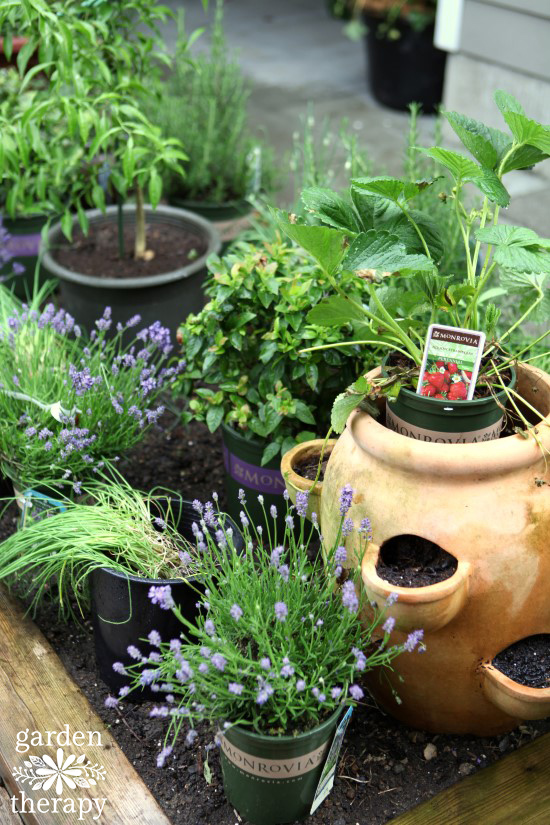
Time for a Kitchen Garden Update!
It’s not often that you hear of a renovation being needed because things are thriving, but in this case, I needed to rethink what the garden would be in the long term, especially with all of that healthy soil and sunlight.
My idea was to add my favourite everyday herbs with a few special and decorative feature plants for interest. Given the size of the space, I hunted for dwarf or container varieties, as well as those that responded well to pruning.
My friends over at Monrovia generously provided me with some beautiful dwarf plant varieties that worked perfectly for the space. I reused some of my containers from the previous garden and divided the herbs to give them more growing room.
Then, I added some annual herbs, such as basil and parsley, around the perennials for practical and decorative purposes.
It’s important that you put your kitchen garden very close to the house. This is considered zone 1 in permaculture design, and it should be easily accessible for you to harvest and maintain the plants on a daily basis.

Culinary Kitchen Garden Plant List
You can customize your kitchen garden with the types of plants you like to feast on, but here is what my newly planted culinary kitchen garden looks like now.
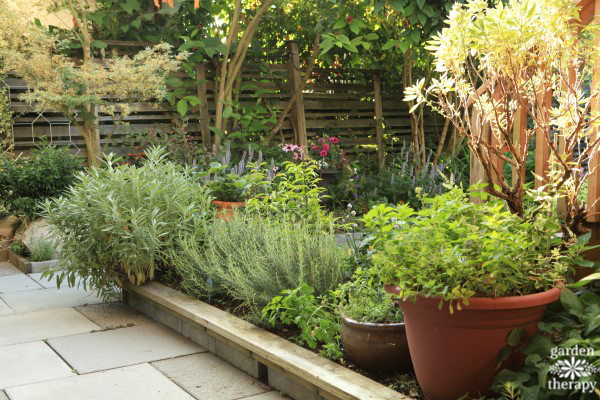
Yuzu
Yuzu (Citrus ichangensis x C. reticulata) is an interesting thorny, lime-coloured tree and a temperate citrus from East Asia. This tree came from one in Japan with a similar climate to the Pacific Northwest and zone 7.
While most citrus requires heat, sun, and at least Zone 8, a yuzu is an interesting addition to my temperate culinary kitchen garden. The fruit is bitter and astringent; used mostly in sauces.
I have yet to taste it, but the fragrant leaves indicate I will use a lot of yuzu in cooking. This dwarf tree will only grow to 6-8′ tall and is cold hardy to 10 degrees F. It is the perfect feature plant to anchor the garden.
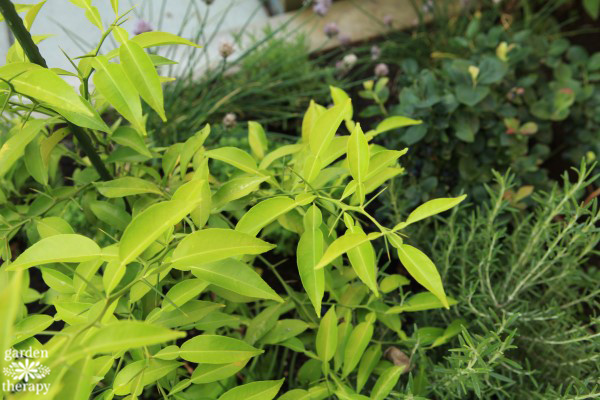
Blueberries
Like the yuzu, these two Brazelberries blueberries are highly decorative, cold-hardy, dwarf, fruit-producing plants.
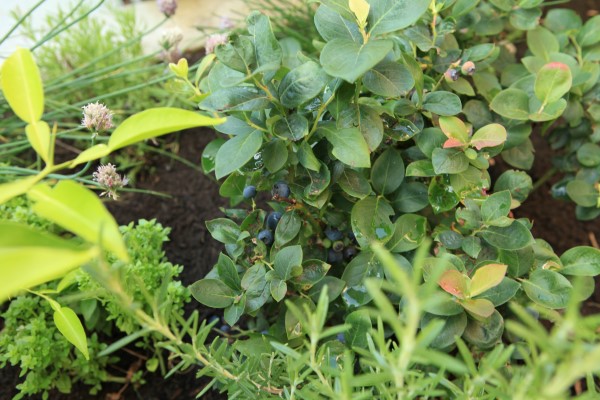
Rosemary
I wanted a dwarf rosemary variety for the garden but decided on one that would respond well to pruning instead.
Arp Rosemary is an upright growing rosemary that can turn into a 6-foot hedge if allowed. Since it responds well to pruning, I plan to keep up with these two plants and harvest a heck of a lot of rosemary throughout the year!
Oregano
I have two types of oregano that share a pot: Hot & Spicy Oregano and Italian Oregano. The Hot & Spicy is fuzzy and has a bit of a bite when raw. It won’t add much spice to a dish when it is cooked, so use it like regular oregano.
The Italian oregano is lime green and easily transplanted to the ornamental garden as a groundcover. I only use a little oregano in cooking, but I like to have plenty in the garden to flower for the bees.

Sage
I have two sage plants that have remained in the space. One large silvery sage in the northeast corner of the bed and a tall sage that has been trained into a 4-foot tall tree. Both provide plenty of herbs for me and flowers for pollinators.
Chives, Nodding Onion
I plant plenty of chives and onions to ward off pests around the garden. Chives have purple, pompom-shaped flowers that will alternate blooming with the lavender.
A nodding onion (Allium cernuum) is planted between the two rosemary plants showing off delicate white blooms that hang upside down.
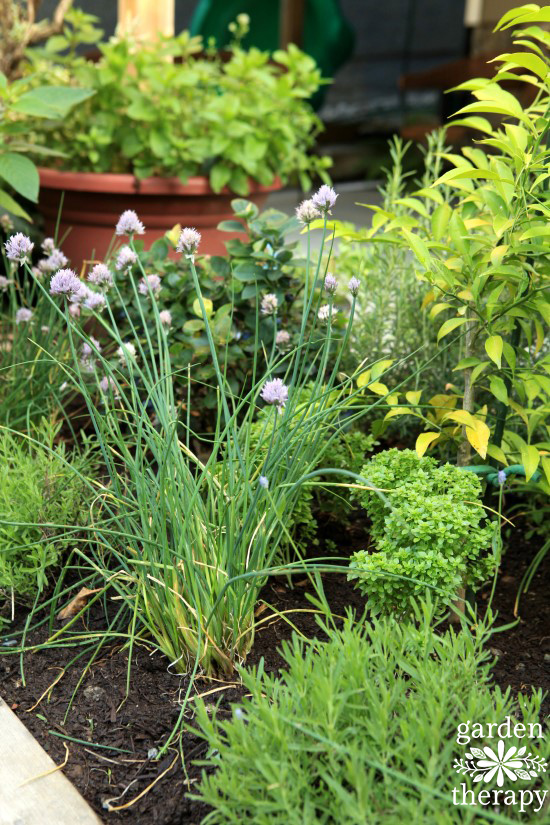
Mint
My mojito mint is a large-leaf, sweet mint labelled only as “Mojito Mint.” It’s contained in a large plastic pot that overwinters well. I can often harvest a few mint leaves well into November.
The dark-stemmed chocolate mint is another favourite. It was a division from my mother’s garden many years ago. It produces chocolate-scented leaves reliably year after year. As mint can be invasive, I keep it contained in pots.
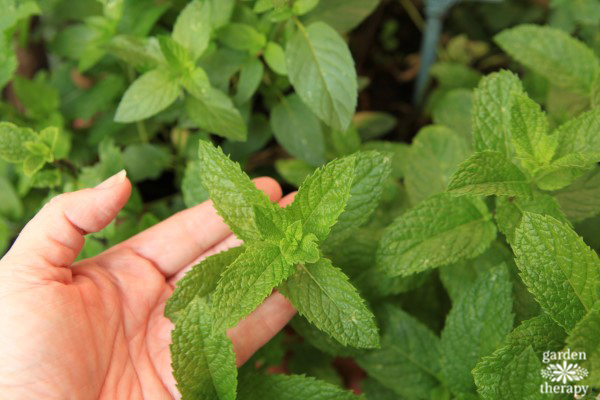
Lavender
Lavender is planted throughout my flower garden, but I felt it needed a place in the kitchen garden as well. You can use it as a culinary herb, like this lavender lemonade. This Thumbelina Leigh English Lavender is a dwarf variety that stays neatly at 12 inches high and wide.
I planted them alternately with chives. The lavender can be cut back after blooming to keep its pretty shape, and it will rebloom up to three times each year.
Strawberries
I have a love/hate relationship with strawberry pots. On the one hand, I love how decorative they are and this one filled with Albion, Seascape, and San Andreas strawberries looks gorgeous.
I have been using it to grow strawberries for many years (as can be seen by the patina on the pot), but I have always been disappointed at how the berries in the lower pockets grow.
I created a perforated watering tube, and then all the plants thrived! I expect a long harvest of fresh strawberries this year.
Annuals
All of the plants I mentioned above are perennials. Unfortunately, not all herbs come back each year. Here are some annuals that I also included in my culinary garden that can be customized every year based on what I’m cooking.
- Italian flatleaf parsley, curly parsley
- Boxwood basil
- Thai basil
- Pineapple sage
Frequently Asked Questions About Kitchen Gardens
A kitchen garden is filled with herbs and produce you often use in cooking. What you plant depends solely on what you eat!
I prefer to plant mostly perennials to make maintenance easy, as the plant will return each year on its own. I also prefer dwarf varieties so I can plant many edible plants without worrying they will outgrow the space.
First, you need to choose a location. The location should ideally be easy to access by the kitchen, usually on or nearby a patio. The sunlight should match the plant’s needs, typically full sun or partial shade. You’ll also want nutrient-rich soil to ensure the plant is fruitful and can handle consistent harvesting.
If you don’t have a garden bed for a culinary garden, you can also grow your edible plants in containers or a raised bed. Even apartments can have a kitchen garden.
With all of these additions to my culinary kitchen garden, I’ll be off to a great start with cooking. I’d be eager to hear about any herbs you grow in your garden that you couldn’t live without. Please share your thoughts in the comments.
More Tips for Growing Food



